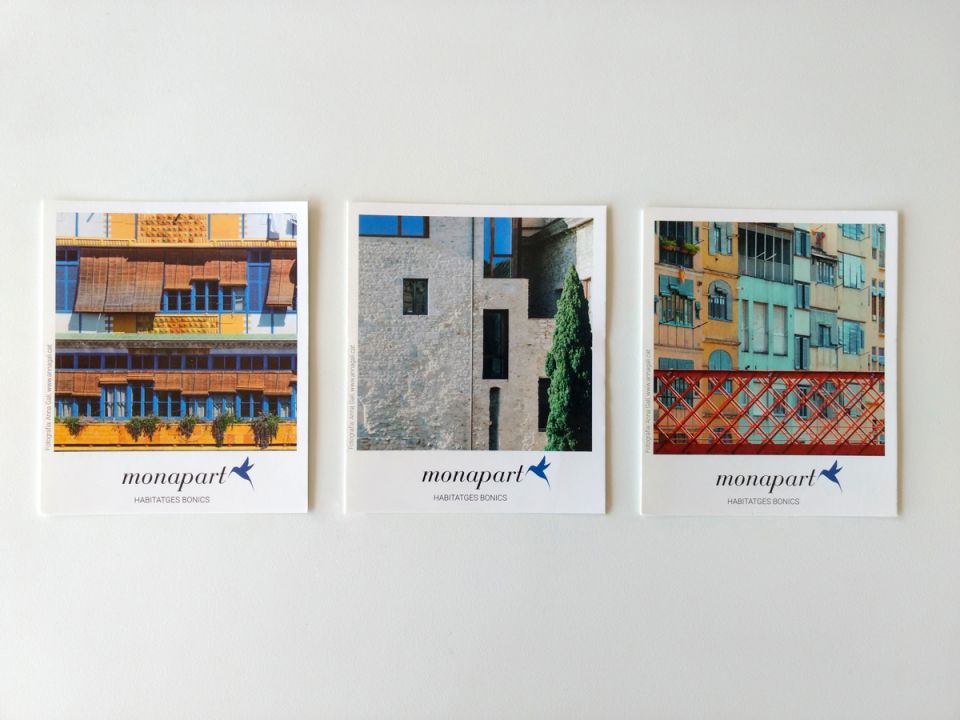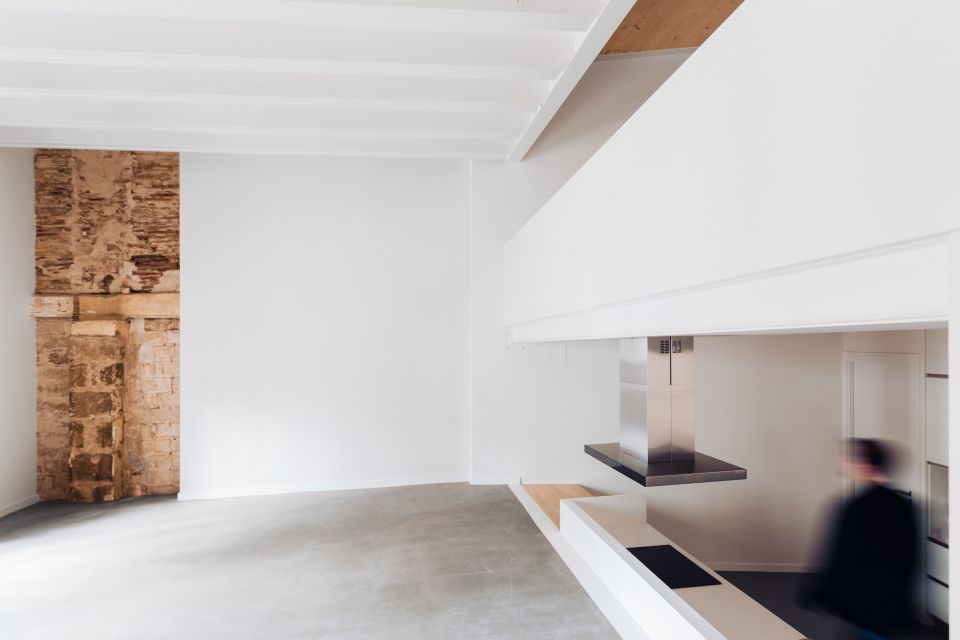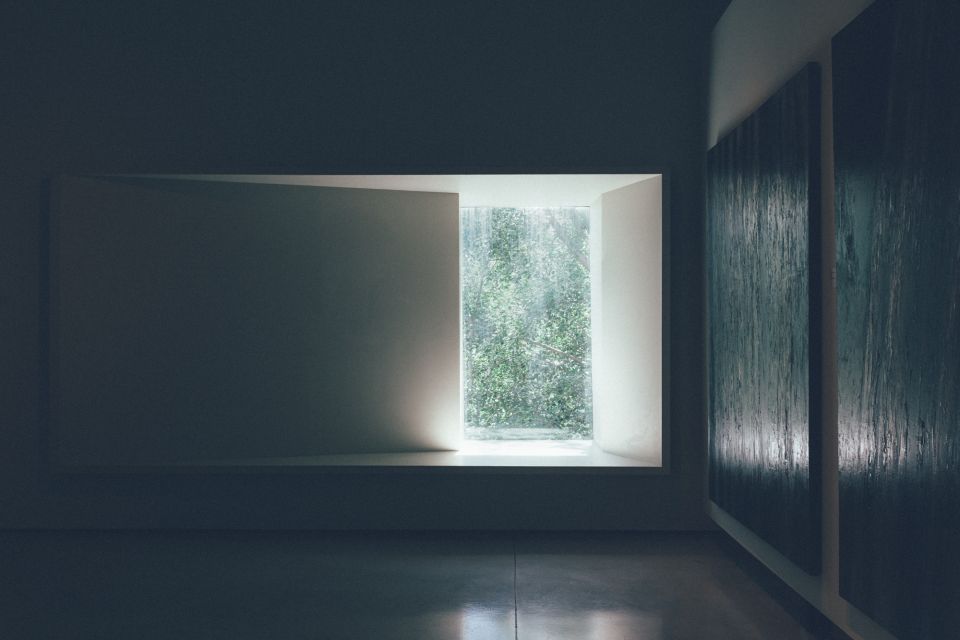When we wanted to take the photos that would illustrate a campaign of bustiada de Monapart GironaWe were looking for someone with a more personal, lively, human, but at the same time very technical approach to photography. How to apply it to architectural photography and make it all fit together? We talked for a while withAnna Galíwho made it possible.

Monapart: Fes-te una foto (textual) a tu mateixa i presenta't breument.
Anna: I'm Anna, I was born in 1968, I live on the edge of the Costa Brava (Lloret) and I'm a photographer 24 hours a day. That doesn't mean that I dedicate myself professionally 24 hours a day, but that photography is with me all the time, whether I carry the camera, which is almost always, or not.
I'm a bit of a rebel, and if I've come to learn anything in the world, it's patience and perseverance. I think I'm making good progress 😉.
I'm interested in any form of creativity: music, cinema, literature, art... and I'd like to have more time to be able to consume more of it.
I have a cat that I think is a cat disguised as a cat.
I have two very different jobs: photography and teaching: I'm an extracurricular "revision" teacher. Fortunately they are compatible, because they both give me things that I wouldn't want to give up.
I resent hypocritical people, I resent diplomacy, and I believe that most of the problems would not exist if we stopped talking more, and more from the heart.
I practice taichi and qigong, and I try to apply their philosophy to life in general. And to photography!
I like driving.
I need my space, and periods of silence and solitude. I need friends and family.
I love Greek cuisine.
I think you get older the day you stop wanting to learn new things.
And I'm afraid that I get very long-winded when I write, concision would not be one of my gifts 😉.
How long have you been working in photography?
Photography has always been present in my life, first in a personal way since I bought my first camera at the age of 16 (after a very hard summer of work selling gelato to tourists) and then in a professional way. I started training myself in a self-taught way but from a certain point I have been attending courses and workshops on specific subjects that have interested me in order to improve both technically and creatively.
In 2010-2011 I entered professionally in the world of social photography (portrait, families, weddings, etc..) but very soon I discovered my passion for interior and architectural photography, probably because of my academic training in mathematics (putting order in space is still geometry, depending on how you look at it) and because of the calmer and more reflective character it has, which I'm sure is linked to my personality. I took a specialisation course on this subject at theInstitut d'Estudis Fotogràfics de Catalunya (Institute of Photographic Studies of Catalonia) and since the end of 2014 I have been collaborating with holiday rental companies such as Airbnb and with architects and interior designers. I try to combine it with more personal creative projects.
"For me, architecture makes sense when people use it, when they make it their own".
How was the experience and the assignment of taking photos of buildings for Monapart Girona?
Girona is one of my favourite cities in the world (if not "the most"), so spending a couple of days walking around it looking for emblematic façades was a pleasure. Walking around aimlessly looking at the world and having the photo "catch my eye" is one of the things I like most, and although in this case there was an enclave in the background and I was looking for a certain type of photo, in the end that was what it was all about.
On the other hand, it is desperate for a photographer to see how in most of the real estate world so little attention is paid to the visual side of the business, and meeting the people at Monapart, who take great care of this aspect, was a pleasant surprise.
What is your differentiating feature, your rarity, with the camera?
Someone told me some time ago that looking at my photos gave me the feeling that something was about to happen. I like the idea.
From my point of view, if I analyse myself, I would say that in general I like to break the rules. It's not always possible in the professional world of architecture, but when I'm allowed to, I do it. I think I'm also characterised by my attention to detail, to materials. I like to play with the light, the backlights, the chiaroscuro. And to find beauty in simple, simple, everyday things that often go unnoticed.
How do you find the roof of a building?
I have never consciously thought about whether I follow some steps to do it, now I'm thinking about it! 🙂
For me, architecture makes sense when people use it, when they make it their own, so I suppose I try to find a way to explain how the people who use that space feel about it, the use they make of it, the things that happen there... in the end, as always in photography, it's about explaining a story through images. On a visual level, I would say that I pay a lot of attention to the light and how it plays with the lines and volumes. And always, when possible, the ideas of the person who designed the space are very important and help to get an idea of the concept behind the building or the space.
But after a phase of analysing the space and planning the points of view that might be interesting and the technical issues, which have to be there, I believe that in the end it is a question of internalising all this information and from a certain point let intuition come into play, let it happen, I think that in the end it's a question of internalising all this information and from a certain point onwards letting your intuition come into play, letting things happen, breathing the space and letting yourself be carried away by the sensations it inspires in you.
What is the architectural style that most inspires you?
Uf, no m'agrada triar! For its strange beauty, brutalism; for its integration with the environment and people, the organic architecture of Frank Lloyd Wright; for itself, but above all for the wonderful photos taken by Julius Shulman, the Californian architecture of the 50s and 60s; for its simplicity, the minimalism of Mies van der Rohe...
But perhaps what motivates me most, leaving aside the architectural style itself, are those projects that combine respect for what is old with modernity and that, whatever the environment, try to integrate nature and people with architecture (or vice versa).
"We have lost all that of opening the photo album and explaining to ourselves our memory, our history (...) photos must be an object we have at hand, we must be able to touch them".
What is your most special project?
Without any doubt, today, "Els Fantasmes de Comala". It is not a purely architectural project, or in some ways it is.
"Els Fantasmes" was born as a graphic part of the disc of the'.Àlex Torío "Ghosts of Comala".which is a musical adaptation/interpretation of the book "Pedro Páramo" by Juan Rulfo. To keep it short and without spoilers, the book tells the story of the protagonist's journey to Comala (Mexico) to claim his rights from his father, the landowner of the village, who had sent him and his mother away. When he arrives at the village he finds it apparently abandoned, but he finds presences... and I won't go on, you'll have to read it!
We took the photos in the Poble Vell de Corbera d'Ebre, in Terra Alta, which was destroyed during the Civil War and which has remained like this until now, because it provided the setting we were looking for. And although at that time I was not a professional architectural photographer, in a certain way it is an architectural photograph, except that the houses fall in sections and that in this case the architecture remains there as a testimony to the past and gives a glimpse of the horror that happened there (real in Corbera d'Ebre, literary fiction in Comala).
Little by little "els fantasmes" grew and ended up as a project that was exhibited at Les Bernardes de Salt i al Pati Llimona in Barcelona among other places. In the exhibition, each photo was linked to fragments of Rulfo's original text and the lyrics of Àlex's album, and with a QR code you could listen to the corresponding song from the album. It was very interesting to work there and to bring together the three artistic disciplines (music, literature, photography) in the same project.
Now "the ghosts" are resting, but one day they will culminate their journey in a photobook that is in the process of being made, because like good ghosts they come and go 😉.
You can see the project here: https://www.behance.net/gallery/20909879/Ghosts-of-Comala https://www.annagali.cat/ghosts-of-comala
Share with us your 3 favourite photos and explain why they are special.
As an editor (in the sense of choosing) of my own photos I'm terrible, but in architectural photography I might stick with these.
The first one corresponds to my first "official" job in architecture.

This is the renovation of a single-family house in Blanes by the team of theEstudi Nus. Now I see the whole series of photos and I can't stop thinking about the many things I would have to improve if I were to take them again, but being the first one, it's one of my favourites.
The other two are at the Can Framis Museum, renovated by Jordi Badia and his team Baas Arquitectura, and are part of my final project in the specialisation course in Architectural Photography. Museums are spaces that I like very much because of the interaction between art, architecture, people and, in the fortunate cases, light. And I fell in love with Can Framis, if one can fall in love with a building, because it is a place where the light and the surrounding nature are as important as the art on display, and where the integration between what is old and what is new has been done with exquisite taste and respect.


Are you planning to make a trip specifically to photograph a certain building?
I'm not much of a photo chaser, but a trip to the United States following in the footsteps of photographers like Stephen Shore and many others, ending in California to visit and photograph buildings by Lloyd Wright, Richard Neutra or Charles Eames would be on the list of things to do.
How do you value the role of social networks and their fugacity in the world of photography?
Social networks (and the internet in general) have generated a hyper-production of images in recent years. Everyone has a mobile phone, everyone takes photos. I don't think the implications for professional photographers are as horrible as some people first thought, because it's one thing to take photos, and quite another to be a photographer, who has to tell a story through his or her images, whatever he or she photographs.
On the other hand, well used social networks can be a good promotional tool to complement the "word of mouth", which I think still works, it is clear that they are another way to show our work to the world. But it's not good to become obsessed with them either, I think we need to continue dedicating more time to learning, to growing as photographers, to finding our own look (and this is sometimes much more difficult because of the bombardment of images we receive every day, because it's easy to fall into the trap of imitating those photographers we like). Having said that, I plead guilty to serving them all!
As for escapism, it worries me above all on a more personal level, because nowadays we take a lot of photos but we don't look at them very often. We have lost the habit of opening our photo album and explaining our memory, our history: we take the photo, share it on social networks, leave it on our mobile or computer and rarely look at it again. And in any case, looking at photos on a screen is not the same, photos have to be an object that we have at hand, we have to be able to touch them.
Un desig pel 2018.
Llum, molta llum 🙂
To be able to bring to fruition a personal photographic project that I have just started and that scares me and excites me in equal parts.
And if I were to ask for more material aspects, I would like to be able to go back to the origins, to analogue photography, to which I have already returned for personal photos, also in the professional world. To be able to photograph architecture with a plate camera would be something I would really like!
"Spaces are designed, occupied and humanised by people, and without them, no space has meaning". How to find the soul of a building? Anna Galí helps us to better understand architectural photography.


